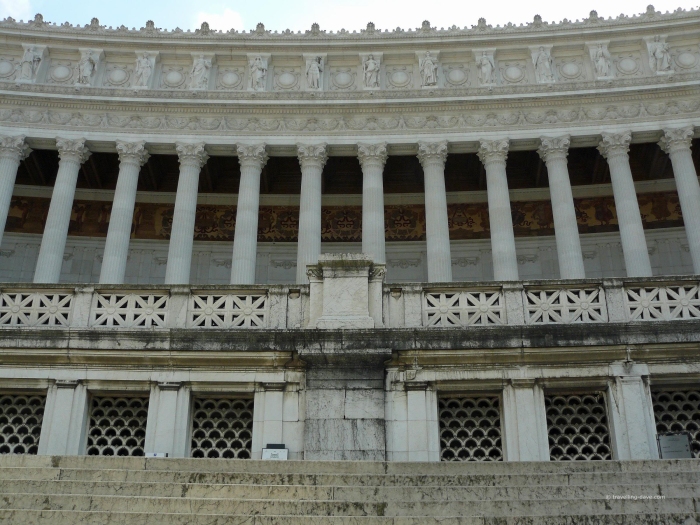Going on a trip to Rome it is like attending an open-air history lesson. The capital of Italy was once the capital of a huge empire and its heart, the Roman Forum, gives an insight of the grandeur of imperial Rome.
Visitors start their exploration from the most popular attraction in Italy: the Colosseum. Tickets can be booked online in advance, an option highly recommended as it will save time queuing up on the day.
This vast amphitheater has survived nearly intact to the present day; walking through its corridors and on the stage, one can only imagine what a spectacle the audience was coming to see: gladiators fighting with each other, fighting against lions and tigers and, at times, the floor of the Colosseum would be flooded to stage mock naval battles for the pleasure of the Emperor and his followers. Today, it is not practical to use it to host events like concerts in the same way as a similar amphitheater in Verona is used for, as the interior of the Colosseum is badly damaged.
Outside the building, the Arch of Constantine stands proud as a gateway to the Roman Forum; the area covers a small valley between the Palatine Hill, one of the most ancient part of the city, and the Capitoline Hill, the site of today’s City Hall.
The ruins of temples, basilicas and a number of palaces can be seen here and, a bird’s eye view of the all area from a terrace on the Capitoline Hill, gives an idea of how, what was originally a marketplace, developed into the heart of imperial Rome.
Other notable buildings nearby are the Domus Aurea, an enormous palace built by emperor Nero and Caracalla Thermal Baths, a complex that in summer hosts operas and concerts, the most memorable probably being the Three Tenors performance in 1990.
A short walk past the Circus Maximus, the site of a chariots racing stadium, and people queuing outside the church of Santa Maria in Cosmedin can be spotted. In the portico of the church, an image of a man-like face carved into a marble circle has an opening where the mouth is: La Bocca della Verita’ (The Mouth of Truth), a modern day Lie Detector!
Legend says that, if someone was lying while their hand was in the Mouth of Truth it would be bitten off. Nowadays potential Pinocchios or, more likely, tourists eager to have a picture taken with one hand in the Mouth, queue up before leaving (with both hands) to explore the area including the Temple of Vesta on the other side of the road.
So many memorable movie scenes were filmed in Rome, from Anita Ekberg taking an impromptu bath in the Trevi fountain in La Dolce Vita to Audrey Hepburn and Gregory Peck touring the city on a Vespa scooter in Roman Holiday. Although bathing is strictly prohibited, it is said that visitors throwing a coin into the fountain (right hand over the left shoulder) will come back to Rome.
Churches are also heavily featured in Rome’s landscape; too many to name them all but, worth a mention, are the Basilica of St.John Lateran and St.Peter in Chains with the famous Michelangelo’s Moses sculpture.
Good views of Rome can be seen from the church of Trinita’ dei Monti, at the top of the Spanish Steps in Piazza di Spagna, another major landmark always crowded with tourists and locals day and night.
Centerpiece of the square, it is the Barcaccia fountain by Pietro and Gian Lorenzo Bernini, at the foot of the Spanish Steps.
From here, the narrow street ahead, Via Condotti lined with designer shops, leads to Via del Corso, a wide boulevard connecting Piazza del Popolo with Piazza Venezia, the site of an imposing monument dedicated to Vittorio Emanuele II.
Its official name is Il Vittoriano but, it has been nicknamed “the wedding cake”. Built with white marble, it is the site of the Tomb of the Unknown Soldier,and it offers 360 degrees views of Rome from its terraces.
Piazza, is Italian for square, and Rome has indeed many of them including Piazza Navona, built on the site of an ancient stadium. It has three fountains: the Moor fountain, the fountain of Neptune and the Fountain of the Four Rivers featured in the movie Angels and Demons.
The movie also featured another of Rome’s famous buildings: the Pantheon. This circular structure accessed through a portico of granite columns has the world’s largest concrete dome with a central opening (oculus).
The river Tiber runs through the city with bridges connecting the two banks; one of them is Ponte Sant’Angelo leading to Castel Sant’Angelo, a circular fortress said to have a secret corridor to the Vatican.
With Rome being the capital of Italy, all the government buildings can be found in the city; the two Parliament buildings: Palazzo Montecitorio seat of the Chamber of Deputies and Palazzo Madama where the Senate is located.
The presidential palace, Quirinale is situated on the tallest hill in Rome, Quirinale Hill and it is open to the public most Sundays throughout the year.
Although the city center is quite compact and easily visited on foot, some of the attractions might require a short trip on the well organized underground system; a popular stop is Ottaviano-San Pietro, alight here if you are planning to visit Vatican City.





































